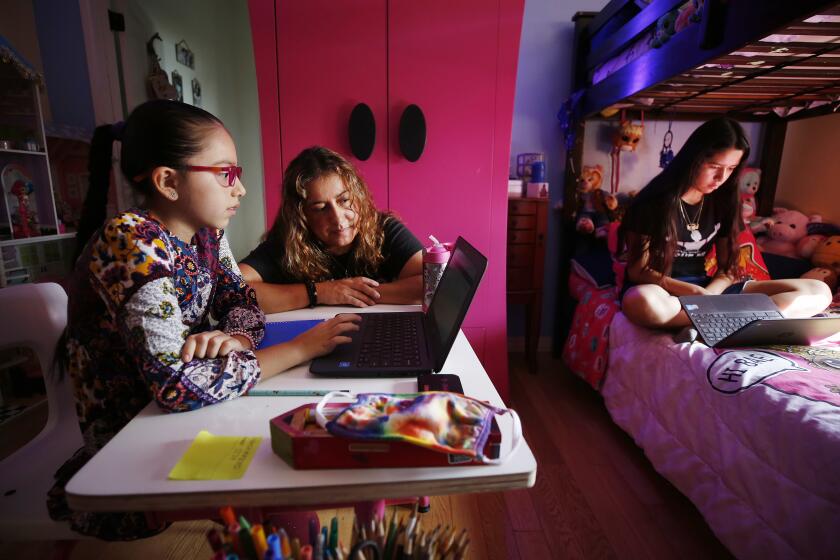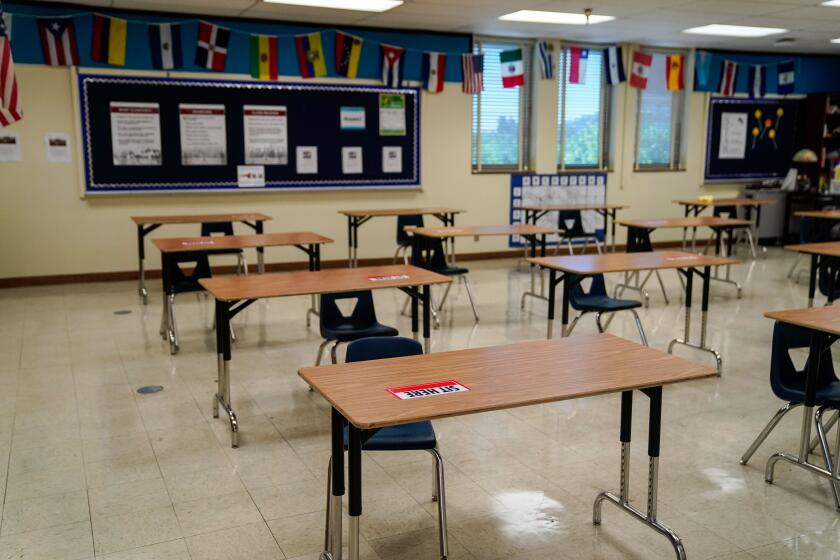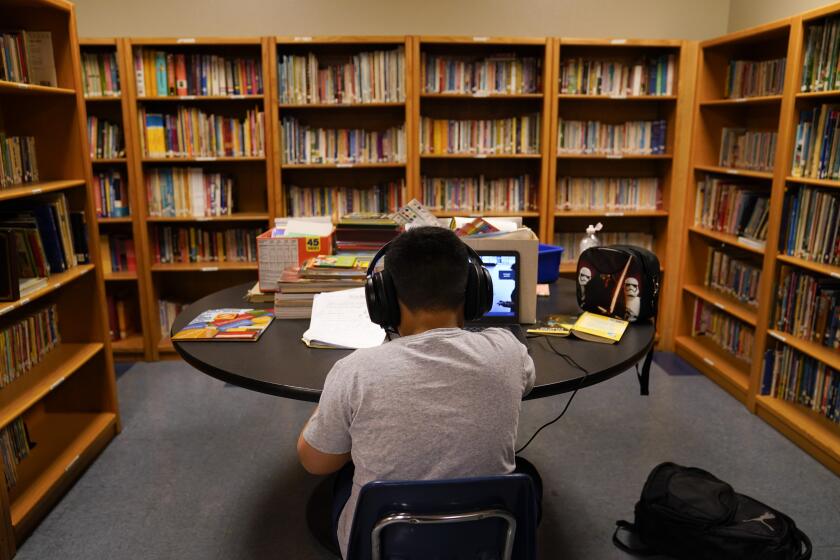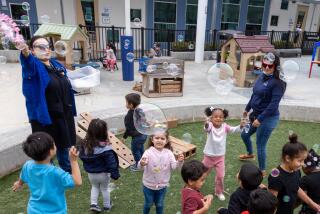How to help young children get the most out of online school
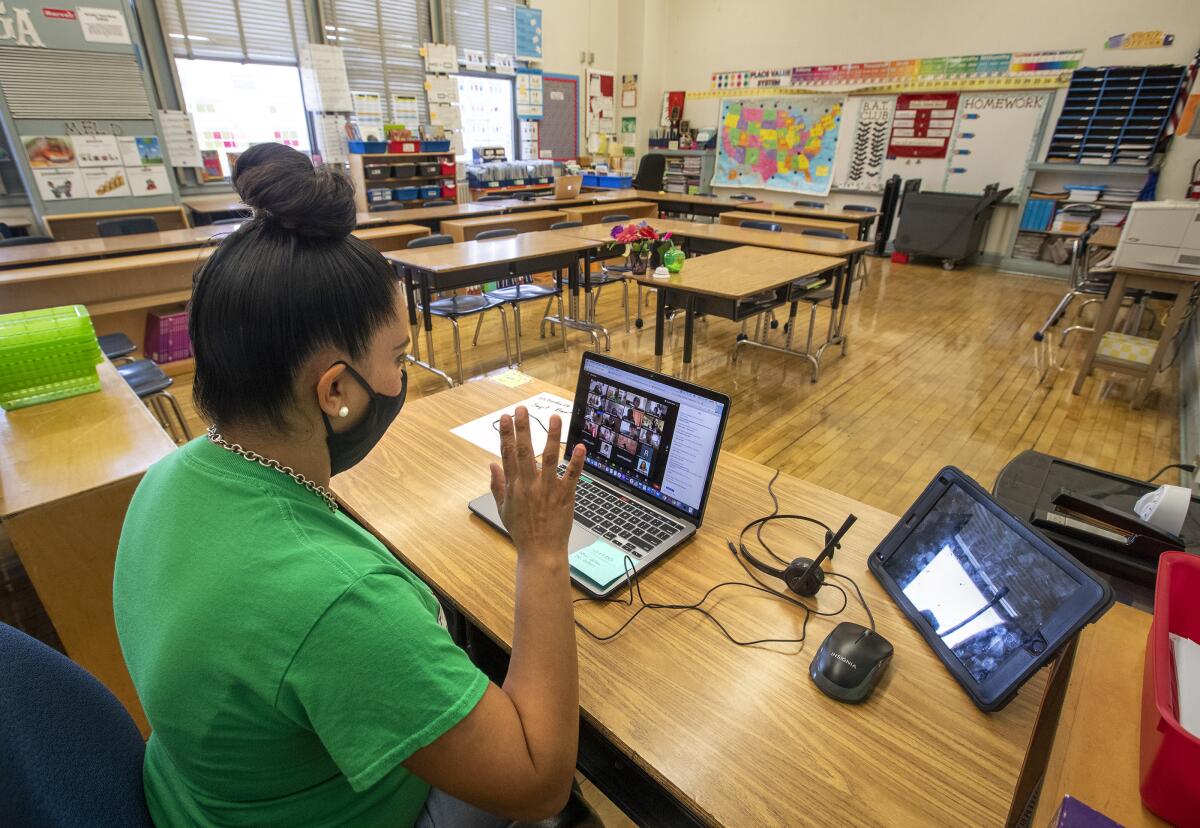
- Share via
Another day in Zoom school, another meltdown and another reminder of what parents already know: Online school is especially challenging for younger students. There’s a reason children from kindergarten through third grade spent much of their pre-pandemic school days moving around and learning through play, not sitting still and staring at at a screen.
Many school districts are prioritizing younger elementary school students for reopenings, as studies show that younger children may be less vulnerable to the coronavirus.
But what if you’re in a school district that’s not reopening anytime soon? What if your child is immunocompromised? Or what if you are reluctant to return to in-person learning in the middle of a pandemic when there are so many “what ifs”?
Then you have to make the most of distance learning.
Many tips for how to best manage distance learning — including creating a designated space for school, maintaining a clear routine and minimizing distractions — are recommended across age groups.
Here are some other ideas that can help, particularly with students in third grade and below.
Understand that this is not natural for kids
“You can’t expect a first-grader to be online all day. You would never want that,” said John Watson, founder of the digital learning company Evergreen Education Group, which hosts the Digital Learning Collaborative and an annual conference to help members understand how to incorporate technology into education.
Amber Francis is a third-grade teacher at Bethany School in Long Beach. She also has a first-grader and a third-grader at home. As the school’s distance learning facilitator, she said that after about 30 minutes, younger students tend to tune out.
“These platforms are built for older kids, assuming a higher level of reading competence, the ability to manipulate a mouse and interface with the computer,” Watson said.
Crying has been part of school life from time immemorial. But never has it had such a vast and motley audience, as young kids’ emotional literacy is tested by COVID-19 and virtual class.
Connect with the teacher
It’s important for all students, but especially younger ones, to feel connected with their teachers.
Even if a teacher is proactive about acknowledging individual students in a Zoom class, it’s impossible to offer encouragement as often as young kids need, Francis said.
Before the pandemic, a teacher was able to walk around the classroom and put her hand on students’ shoulders.
But online, children can feel ignored when their teacher doesn’t see them raising their hands or can’t answer their questions right away.
“Last year, at least we were finishing up with the students we were with in the classroom,” said Laurie Campbell, an Orange Coast College professor and program coordinator for the school’s early childhood education department. “But we’re starting this year where we don’t know our students.”
Watson and Campbell said the teachers who have been most successful are the ones who take the time to talk to students, maybe even leading a group yoga session, before jumping into academics.
Many teachers also offer online office hours, which could be a good time for a one-on-one chat to nurture a deeper connection or for a student to just hear that the teacher is rooting for the student.
The new school year of remote learning will bring unique challenges. Here are guides to help parents of school-age children navigate remote learning, as well as recent updates about education in Southern California.
Positive encouragement from home
Francis recommends setting up a positive behavior management system, a philosophy explained in the 1-2-3 Magic parenting program, to keep kids motivated.
In the spring, when Francis realized she had to not only manage her own classroom online, but also make sure her own young kids were set up for distance learning, she used a star chart and bought a rewards wheel, letting her kids spin it for small prizes if they had a good school day.
She explains that adults can be motivated to work by getting a paycheck every two weeks, but kids need more frequent reminders.
So depending on the child, she suggests giving a star for every 15 minutes they sit in the chair. Some kids may need to be reminded every five minutes. Others might need you to be more specific about what they need to do to get a star.
“We use a punch-card system,” said Joanna Inurreta, mother of a kindergartner and third-grader at Fullerton’s Pacific Drive Elementary School. “You know, one you would find in a restaurant, where if they get 10 punches, they get a reward.”
She lists toys, books or puzzles as the prizes for paying attention or participating.
“Getting an 8-year-old and 5-year-old to focus is not easy, so you do what you can,” she said.
Here are some ways working parents can more easily juggle their own jobs and kids’ school when everyone’s home — and ways employers can support working parents.
“It’s much harder as a parent,” Francis said. “My student will obey me 100 times more than my own kids.”
But if parents are frustrated, kids will also get frustrated, and then they associate negative feelings with school, she said.
You can gradually phase out the rewards system once a student learns good habits.
Campbell is more wary about a rewards system that links good practices to an extrinsic reward, as opposed to the joy of learning.
She recommends a “first-then” schedule, which is also often used in special education. It involves explaining, as much as possible, what needs to get done and deciding together what the student wants to do first, before they then get a break or can do an activity of their choosing.
This helps parents find a developmentally appropriate practice for their kids, based on their preferred activities and attention spans. More important, students will feel they are part of the process, she said. It makes sense if it isn’t working
As distance learning became the norm during the pandemic, some lower-income families didn’t have access to technology, internet or help at home, a Los Angeles Times survey found, which is leading to greater gaps in educational inequities.
Even privileged families that are equipped for distance learning have struggled.
“It really comes down to the kid’s learning style,” Campbell said. “Some kids will do great, and others will not. It’s hit or miss.”
Online schools, which have spent decades researching how to do virtual learning effectively, never try to replicate the experience of an in-person school through a computer, Watson said.
They change their approach to meet the same educational goals.
Live lessons are usually a very limited part of their schedules, he said. Often, they use a lot of paper materials, pre-recorded videos, and science labs that can be done outdoors, and they gather online only to discuss what they learned offline.
Maybe your kid learns better while moving around.
“It’s hard because most parents don’t understand childhood development, but you know your child, and you know what their limits are,” Campbell said.
“I think we as parents really need to advocate for our children,” she added. “If this process is not working, talk to the teacher to see if there is another way. Collaboration and partnership go a long way. There’s not one answer that’s going to fit for every situation.”What’s most important for grades K to 3
- Reading: “If your kid is not a good reader by about third grade, school becomes harder because you learn from reading,” Francis said. Practice sight words and phonics with your children, sounding out the letters and making sure they can distinguish different sounds.
- Math: If sitting still for addition and subtraction worksheets is challenging, Campbell said, there are ways to learn math through play: “Go on a walk, collect rocks, leaves and sticks, and then sort and classify them.”
- Make believe: “Give them time to imagine and create stories in their heads,” Francis said. “That’s what makes them good storytellers, and if they can’t visualize the stories in their heads, they get stuck when they start writing.”
- Follow their curiosity: Ask your children questions. Spend more time on the subjects they like. Be a model for them by showing your own interests and passions.
- Social and emotional learning: Teach your kids how to take turns and how to solve problems through communication when there is conflict. This includes talking to them about how they are feeling when they are frustrated with online school. “Say, ‘I know this is really hard. And this is not what we want it to be, but this is the way it is right now,’” Campbell said. “‘What can we do together to get this done so we can move on to something else?’ I think just acknowledging their feelings could be a huge motivator for kids, that they feel understood.”
Times staff writer Andrew J. Campa contributed to this report.
More to Read
Sign up for Essential California
The most important California stories and recommendations in your inbox every morning.
You may occasionally receive promotional content from the Los Angeles Times.
